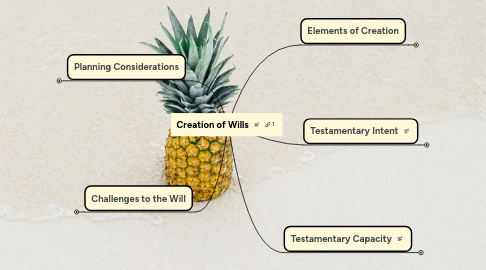
1. Planning Considerations
1.1. Only interested parties have standing to challenge a will
1.1.1. In re Estate of Getty, 85 Cal. App. 3d 755 (1978)
1.2. Structural Elements to Prevent Challenges
1.2.1. No Contest or Alternative Dispute Resolution Clauses
1.2.1.1. Lipper v. Weslow, 369 S.W.2d 698 (Tex. Civ. App. 1963)
1.2.2. Explanations and Precatory Language
1.2.3. Living Probate
1.2.4. Living Trust and Other Gifts
1.3. Conduct While Executing Estate Plan
1.3.1. Pros and Cons of Making a Writing or Recording
1.3.2. Choosing Witnesses
1.3.3. Disclosure to Family of Estate Plan
2. Elements of Creation
2.1. Testamentary Intent
2.2. Testamentary Capacity
2.3. Compliance with Local Statute of Wills
3. Testamentary Intent
3.1. Title of document
3.2. Formalities of execution
3.3. Language in the document embodying an intent to have the document control disposition of property upon testator's death
4. Challenges to the Will
4.1. Insane Delusion
4.1.1. If an insane delusion has infected the entire will then the entire will is nullified
4.1.2. If an insane delusion has infected a particular provision of the will, then only that provision is invalid
4.1.3. If the insane delusion doesn't affect a distribution, then the will is still valid
4.2. Mistake
4.2.1. The traditional rule is that no remedy is provided for a mistake unless the mistake appears on the face of the will and what the testator would have done but for the mistake also appears on the face of the governing instrument.
4.3. Duress
4.3.1. A threat or coercive act that was made by a wrongdoer with the intent of coercing the testator to make a donative transfer that would not have been made but for the threat or coercive act
4.4. Undue Influence
4.4.1. A showing of suspicious circumstances or a confidential relationship with the influencer that could have influenced the testator
4.4.1.1. THe testator must have been susceptible to the influence of the influencer
4.4.1.2. The influencer must have had the opportunity to influence the testator
4.4.1.3. The influencer must have had the disposition to influence the testator
4.4.1.4. The result of the influence must be in the influencer's favor
4.4.2. Factors that show the influence was undue
4.4.2.1. Nature of relationship
4.4.2.2. Participation by beneficiary in creation of testamentary document
4.4.2.3. Extent of secrecy and haste
4.4.2.4. Extent of change from old estate plan to new estate plan
4.4.2.5. No existence of independent advice that can cleanse or insulate the new estate plan
4.5. Fraud
4.5.1. Fraud in the Inducement
4.5.1.1. Intentional misrepresentation by fraudster
4.5.1.2. Reliance by the testator on the misrepresentation
4.5.1.3. Misrepresentation caused the testator to execute a will, revoke a will, refrain from executing or revoking a will, or modify a particular provision in the wrongdoers' favor
4.5.2. Fraud in the Execution
4.5.2.1. Intentional misrepresentation by wrongdoer of the character or contents of the testamentary instrument
4.5.2.2. Reliance by testator on misrepresentation
4.6. Tortious Interference With Expectancy
5. Testamentary Capacity
5.1. N.C. Gen. Stat. § 31-1 Who may make a will
5.2. A person is of sound mind whenever the person comprehends
5.2.1. The natural objects of the person's bounty
5.2.2. Understands the kind, nature, and extent of the person's property
5.2.3. Knows the manner in which he desires his act to take effect
5.2.4. And realizes the effect his act will have upon his estate (How the above elements relate)

